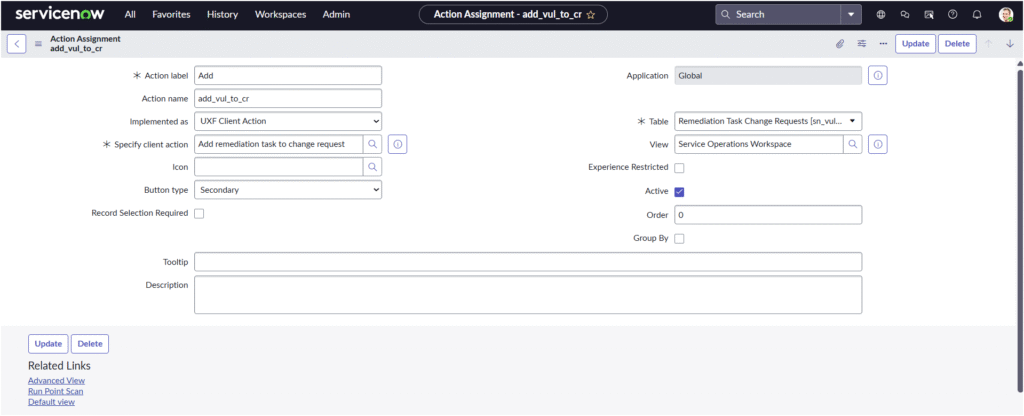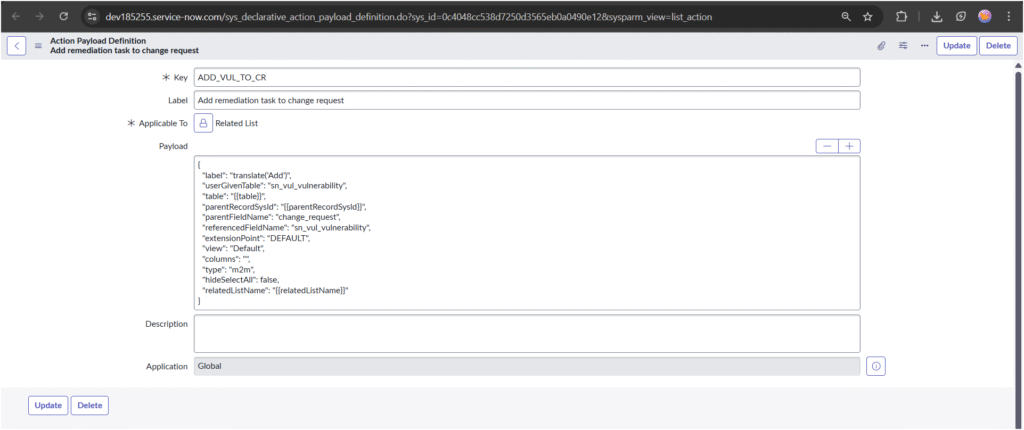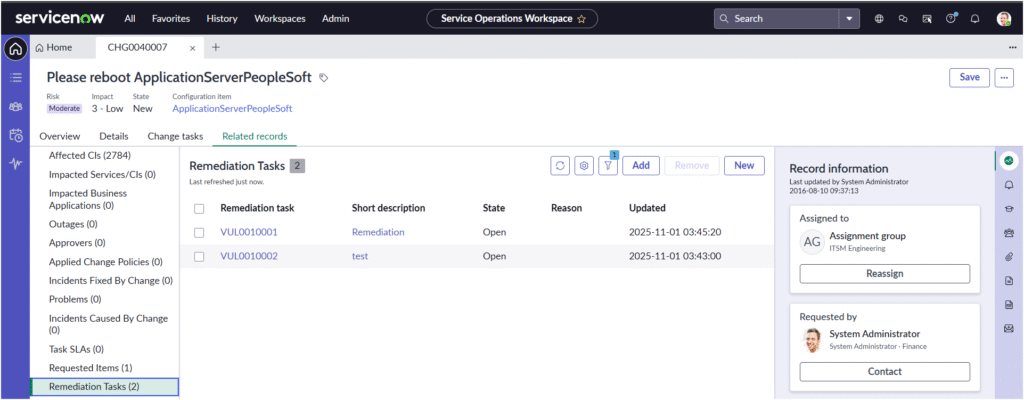When many-to-many (m2m) related lists such as Requested Items or Remediation Tasks are added to a Change Request record in Service Operations Workspace (SOW), you’ll notice there are no “Add” or “Remove” buttons available out of the box.
These must be manually configured using Now Experience Declarative Actions.
This article focuses on creating the Remove action specifically for m2m related lists.
1. Understand the M2M Relationship
Each related list on the Change Request record (for example, Requested Items or Remediation Tasks) is based on an m2m table:
| Related List | M2M Table | Description |
|---|---|---|
| Requested Items | sn_vul_m2m_vg_change_request | Links Requested Items to Change Requests |
| Remediation Tasks | sn_vul_m2m_vul_change_request | Links Remediation Tasks to Change Requests |
When you create the Remove declarative action, make sure the Table field targets the m2m table, not the primary table like sn_vul_vulnerability.
2. Create the Declarative Action Record

Navigate to:
Now Experience Framework → Declarative Actions → Related List Actions
Create a new record with the following configuration:
| Field | Value |
|---|---|
| Action label | Remove ({{count}}) |
| Action name | remove |
| Implemented as | Server Script |
| Button type | Secondary |
| Record Selection Required | ✓ Checked |
| Active | ✓ Checked |
| Table | sn_vul_m2m_vul_change_request (for Remediation Task M2M) |
| View | Service Operations Workspace |
💡 You can duplicate this setup for other M2M tables such as
sn_vul_m2m_vg_change_requestif you need similar functionality.
3. Add the Server Script
Use the following server script to remove the selected M2M relationship record:
if (current.deleteRecord()) {
gs.addInfoMessage(gs.getMessage("Record {0} removed successfully.", [current.getDisplayValue()]));
} else {
gs.addErrorMessage(gs.getMessage("Unable to remove record {0}.", [current.getDisplayValue()]));
}
This script deletes the selected M2M record and displays a success or error message in the workspace UI.
4. Configure the “Add” Declarative Action (for context)

If you are also setting up the Add action for M2M tables, make sure to configure the Action Assignment, Payload Definition, and UX Add-on Event Mapping records as follows:
Action Assignment
- Action label: Add
- Action name: add_vul_to_cr
- Implemented as: UXF Client Action
- Specify client action: Add remediation task to change request
- Table:
sn_vul_m2m_vul_change_request - View: Service Operations Workspace
- Active: ✓ Checked
Action Payload Definition
Example payload for Add remediation task to change request:
{
"label": "translate('Add')",
"userGivenTable": "sn_vul_vulnerability",
"table": "{{table}}",
"parentRecordSysId": "{{parentRecordSysId}}",
"parentFieldName": "change_request",
"referencedFieldName": "sn_vul_vulnerability",
"extensionPoint": "DEFAULT",
"view": "Default",
"columns": "",
"type": "m2m",
"hideSelectAll": false,
"relatedListName": "{{relatedListName}}"
}
UX Add-on Event Mapping

- Source Component: Related Records
- Source Declarative Action: add_vul_to_cr
- Controller: Form
- Target Event:
[Record Page] Open modal
Example Target Payload Mapping (partial):
{
"container": {
"fields": {
"container": {
"columns": { "binding": { "address": ["columns"] }, "type": "EVENT_PAYLOAD_BINDING" },
"extensionPoint": { "binding": { "address": ["extensionPoint"] }, "type": "EVENT_PAYLOAD_BINDING" },
"hideSelectAll": { "binding": { "address": ["hideSelectAll"] }, "type": "EVENT_PAYLOAD_BINDING" },
"label": { "binding": { "address": ["label"] }, "type": "EVENT_PAYLOAD_BINDING" },
"parentFieldName": { "binding": { "address": ["parentFieldName"] }, "type": "EVENT_PAYLOAD_BINDING" },
"parentRecordSysId": { "binding": { "address": ["parentRecordSysId"] }, "type": "EVENT_PAYLOAD_BINDING" },
"referencedFieldName": { "binding": { "address": ["referencedFieldName"] }, "type": "EVENT_PAYLOAD_BINDING" },
"relatedListName": { "binding": { "address": ["relatedListName"] }, "type": "EVENT_PAYLOAD_BINDING" },
"table": { "binding": { "address": ["table"] }, "type": "EVENT_PAYLOAD_BINDING" },
"userGivenTable": { "binding": { "address": ["userGivenTable"] }, "type": "EVENT_PAYLOAD_BINDING" },
"view": { "binding": { "address": ["view"] }, "type": "EVENT_PAYLOAD_BINDING" }
},
"type": "MAP_CONTAINER"
},
"params": {
"container": {
"type": { "binding": { "address": ["type"] }, "type": "EVENT_PAYLOAD_BINDING" }
},
"type": "MAP_CONTAINER"
},
"route": { "type": "JSON_LITERAL", "value": "mra" },
"size": { "type": "JSON_LITERAL", "value": "lg" }
},
"type": "MAP_CONTAINER"
}
5. Validate in Service Operations Workspace

- Open a Change Request record in SOW.
- Navigate to Related Records → Remediation Tasks (or another M2M list).
- You should now see Add and Remove buttons above the related list.
- Use Add to link new tasks, and Remove to unlink existing ones.
🧠 Remember to Clear Cache
After creating or modifying Declarative Actions or UX mappings, run the following in your instance to refresh the UI cache:
cache.do
Then refresh your browser.
✅ Summary
By configuring Add and Remove Declarative Actions for M2M related lists, users can manage relationships like Remediation Tasks and Requested Items directly in the Service Operations Workspace, streamlining change management processes and improving usability.

